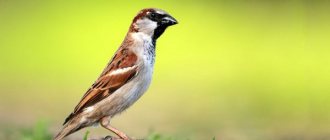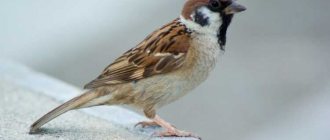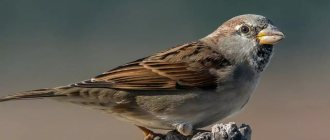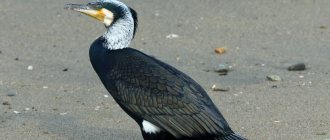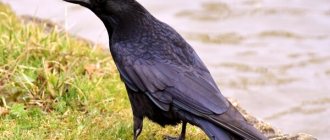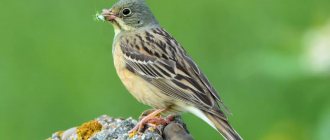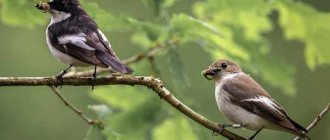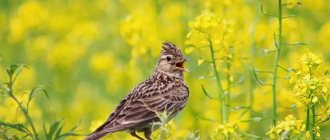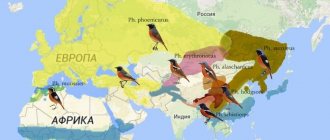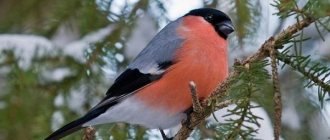The tree sparrow is a very common bird in our latitudes. Outwardly, it is very difficult to distinguish it from an ordinary house sparrow, but there are still differences.
There are slight differences in the color and structure of feathers, by which it is possible to distinguish related birds, as well as a slight difference in size - field birds are smaller than their house counterparts. And it is also worth considering that the field subspecies completely lacks sexual dimorphism, that is, the female does not differ in appearance from the male, which cannot be said about house sparrows.
Appearance
Externally, the tree sparrow bears a very close resemblance to the house sparrow of this genus, which is constantly found in any populated area. However, experienced ornithologists will be able to immediately identify the distinctive features in the appearance of this bird.
Like its urban brother, the tree sparrow has a brownish body, however, it has vertical stripes of a darker shade. But the abdomen and chest have a brown-gray color, which is characteristic of this family. Another characteristic feature of the bird is the white stripes on its wings.
But the head of the tree sparrow distinguishes it from its urban relative. Unlike other representatives of its family, the head and back of the head are brown, and the neck is decorated with a small black spot. The small bird's cheeks are white, decorated with a black spot located around the ears. And the neck of this baby is decorated with a light-colored collar.
Sparrow photo
Description
The tree sparrow (Passer montanus) does not have such pronounced sexual dimorphism as its house brother - the males and females of these birds are almost identically colored. In addition, it is significantly smaller than the house sparrow: its mass ranges from 20 to 30 g, while the house sparrow's mass ranges from 28 to 38 g. The tree sparrow has a pleasant brown color on the top of its head, the so-called “cap,” which is why in Western countries it is called the red-headed sparrow. The frenulum, the stripe under the eye, the throat and ear coverts are black, and there are black dots on the white cheeks - by this feature the tree sparrow can be easily distinguished from the house sparrow. The plumage of the tree sparrow's back, wings and tail is brown, often with dark trunks and light ocher edges of the feathers; the belly is whitish, the sides of the neck are also white; the beak is brownish-black in winter with a yellow base, black in summer; legs are pale brown. The plumage of young birds is much duller than that of adults; the top of their heads and backs are grayish-brown with dark streaks; belly dirty white; The throat, frenulum and ear coverts are grey. Ornithologists distinguish between 7 and 33 subspecies of tree sparrows.
Where do they live?
Initially, tree sparrows had a fairly limited habitat. They could only be found in the temperate climate of Eurasia. However, like a person, this baby does not sit still. As soon as man learned to cross the Pacific Ocean, this little one crossed it with him. And so it turned out that in modern times the tree sparrow is found in North America, Australia, and southern Africa. The sparrows swam to these continents along with people and easily settled there.
The most convenient places for them to live are open forests, forest-steppes and forest edges. Unlike their urban counterpart, these birds diligently avoid meeting people. Although recently, tree sparrows have been left with no choice but to settle closer to people and look for food in populated areas. The thing is that their natural habitats are being rapidly destroyed today.
Tree sparrow video
Habitat of house sparrows
In ancient times, the house sparrow lived only in the vast expanses of Northern Europe. However, already at the beginning of the 20th century, this bird was brought to almost all corners of the globe. Currently, this bird is found throughout almost the entire territory of Eurasia, except for the extreme east and northeast of the continent. It also lives throughout almost the entire territory of North America, southern South America, South Africa and eastern Australia.
This is one of the most famous birds that live in the vicinity of human habitation.
Lifestyle
In most cases, tree sparrows, like other members of their family, prefer a solitary life with their mate. Although recently there has been a tendency towards collectivism among tree sparrows. Nowadays, it is increasingly possible to find colonies of these birds, in which there are from five to six nests. A larger number of nests is still rare.
Speaking of couples, sparrows are monogamous. If a pair was created before the nesting period, they will remain faithful to each other at least until the end of the mating season, and often one pair of sparrows remains together for life.
As mentioned above, the small wingspan does not at all prevent this bird from leading an active lifestyle. As a rule, flocks of this species of sparrows stay apart, avoiding communication with both people and their close relatives, house sparrows. However, sometimes there are cases when representatives of these two species not only live peacefully next door, but also form pairs with each other.
A high level of socialization is a characteristic characteristic of the passerine family and is not alien to tree sparrows. Although they live a solitary life, outside the mating season they can easily coexist peacefully with both their brothers and other small birds.
In winter, when food is in limited quantities, then, according to the hierarchy, some sparrows in the flock have an advantage in food over others. As a rule, this advantage is given to birds whose neck spot is the largest. It is by displaying this spot that sparrows drive their relatives away from food.
Tree sparrows are small birds that are absolutely defenseless against predators, so they have plenty of natural enemies in nature. However, the main enemies include hawks, owls, raccoons, snakes and domestic cats.
Photo of a tree sparrow
Sparrow habitat
In the cold winter, when there are very few birds, or in the hot summer, when the voices of many birds are heard, a small, gray-brown bird is always next to a person - a sparrow, to which people are so accustomed that they have not noticed it for a long time. And in vain.
The sparrow is a small bird, in size and weighing no more than 35 g. But few people realize that it is an unusually smart, observant and cautious bird. Otherwise, she would not have chosen such a smart, unpredictable and dangerous neighbor - a man. And the sparrow not only gets along easily, but also explores new lands with humans.
So, for example, following a person, this little one moved to Australia, settled in the north of Yakutia, even agreed to the tundra and forest-tundra, although she was not at all comfortable living there. Now there are few places on the planet that are not inhabited by sparrows.
The sparrow does not fly to warmer climes and, in general, prefers to lead a sedentary lifestyle. However, this does not prevent him from flying outside the already selected territories in order to look for new, unoccupied areas.
What birds are similar to them
The tree sparrow is very similar to all other members of the passerine family. However, with each type of sparrow they have different similarities:
House Sparrow
The field sparrow is most similar to this species. First of all, they are similar in appearance, since they have similar plumage colors. Among other things, these birds have the same diet.
House Sparrow
Stone sparrow
Fieldbirds have a common way of life with this species of sparrow. The stone fellow, like the tree sparrow, prefers a solitary life or lives in very small colonies.
Stone sparrow
Black-breasted Sparrow
Externally, these two types of sparrows are very difficult to distinguish from each other. An ordinary person will even say that this is the same bird. Ornithologists will see the difference without difficulty. The Spanish relative of the tree sparrow is similar in size and also lives in small colonies.
Photo of Black-breasted Sparrow
Natural enemies of sparrows
Sparrows, being quite small birds in size, like other birds, have many natural enemies. The greatest danger to them in urban environments is cats. These predators are able to keep sparrows away from feeders and attack those individuals that have lost their vigilance.
For sparrows living in the wild, other birds of prey are their natural enemies. During the day, this problem can be caused by hawks, who prefer to hunt large and small birds. At night, the main problem for sparrows is owls, who are excellent at navigating in the dark and easily overtake their prey if it is outside the nest.
In addition, the sparrow’s body is designed in such a way that its anatomical features simply do not allow it to fly to another region. Birds have rather small wings and a dense body that is poorly adapted to prolonged physical activity.
What do they eat
The basis of the diet of these babies is the seeds of almost all existing plants. A sparrow never goes alone in search of food. For safety reasons, these birds gather in a small detachment and go in search of food. They look for food almost everywhere: on the ground, on trees, on bushes, and so on.
Tree sparrows feed their offspring mainly with food of animal origin. Thus, the basis of the diet of the young consists of various invertebrates and insects that the parents bring to their chicks.
The process of obtaining food from sparrows is carefully organized. Since sparrows are defenseless little creatures, when feeding they have to post sentries who carefully monitor so that the flock is not attacked by the enemy. While the watchmen are watching the area, the other birds take turns feeding, last of all giving the watchmen themselves food. If, during the feeding process, the sentinels notice danger, then the entire flock, at their call, flies to a safe place. The youngest individuals look for food, which also indicates their socialization.
Photo of how sparrows eat
Listen to the voice of the tree sparrow
Tree sparrows sometimes build their nests in the most unusual places - under the roofs of houses, in tree hollows, in birdhouses and abandoned burrows of other birds and animals. From late April to July, females lay two clutches of eggs, 3-5 in each. In warm countries, the breeding period increases several times. The main thing is that there is an abundance of insects, which are the main food for the chicks.
During harvest, a large concentration of sparrows can cause significant damage to agriculture.
After 10-14 days, the chicks hatch, which both parents begin to feed intensively. After 15-20 days, the chicks fledge and are already able to fly. The young gather in flocks and stay close to the nesting site until cold weather.
Due to the fact that this bird is widespread, it is not threatened with extinction, and all fluctuations in population numbers caused by various factors disappear after the cause disappears.
If you find an error, please select a piece of text and press Ctrl+Enter.
What do nests look like and where are they?
As such, tree sparrows usually do not build a nest in a species familiar to humans. As a rule, these birds use ready-made houses that were abandoned by their previous owners. Thus, a female tree sparrow can hatch her offspring in completely different conditions. The nest can be a hollow tree, a crevice in a rock, an empty birdhouse, an abandoned nest of another bird, regardless of the size of the previous owners.
Tree sparrow nest
Reproduction
These little birds, like all representatives of the animal world, begin to reproduce with the onset of puberty. As a rule, they reach puberty after a year of life. Tree sparrows are distinguished by their monogamy; one pair can be together for several mating seasons, or even their entire life. However, cases often occur when a male mates with a neighboring female, leaving his offspring for the neighbor.
The mating season for sparrows usually begins in April and lasts only a month or two. During this time, the female is able to lay from four to six eggs. The eggs are small in size and light brown in color with specks of a darker shade. Sparrows usually hatch eggs no more than two weeks.
The young are born completely helpless. The chicks not only have no feathers, but in addition they also do not see anything. Until the young animals become stronger, both parents feed them. This period usually takes no more than three weeks, during which time the chicks acquire their plumage and can begin to learn to fly. Learning to fly takes another couple of weeks, and after that the young animals leave the parental nest forever and begin an independent life.
Thus, one pair of tree sparrows in one mating season is quite capable of raising two or even three generations of chicks.
Photo of a sparrow in winter
Character and lifestyle of a sparrow
It is worth saying that sparrows have a bad character. They are jealous of their possessions, and every time they start serious fights (with the same tits) for their yard, park or other warm places.
By the way, if there is no encroachment from other birds, sparrows can easily cause a scandal with their relatives. Moreover, in terms of the intensity of passions, he will not yield to a fair defense of his nest. Who hasn't heard the voice of a sparrow , especially in early spring.
The sparrow is completely uncharacteristic of being quiet and silent. Any movement of anyone causes a violent wave of emotions in a flock of these birds.
Listen to the sparrow's voice
And in the spring, when married couples are created, sparrows simply organize bird fights. Fights can start on the roof of a house, on a tree branch and continue high in the sky. As a rule, it doesn’t lead to bloody wounds; sparrows are too smart for that; after fights, the bullies scatter, but not for long.
This bird at home, what to keep, what to feed
Keeping this bird in captivity is not that difficult. The main thing is to provide her with a spacious enclosure where she can move. However, the right living conditions are not the most important thing in its maintenance. The most important thing is nutrition. The diet of sparrows in captivity must be balanced and as close as possible to their diet in their natural habitat. Fortunately, today there are already special foods for passerines, which contain all the vitamins, microelements and minerals necessary for a small bird.
Tree sparrow feeding its chicks
How long do they live?
For such a small bird, the sparrow lives a fairly long life. The tree sparrow in its natural habitat lives on average from eight to ten years. Which is not small, considering the number of enemies he has and the complete defenselessness of the bird. In captivity, this figure increases and, if properly kept in captivity, a sparrow can live fifteen years.
Close-up photo of a tree sparrow
Sparrows - species, where they live, features
In almost every courtyard of Russian cities you can find flocks of small cheerfully chirping sparrows. They also live near villages and hamlets, and often fly into farmsteads to feed. What these two species of birds have in common is that they all settle near human habitation. But few people know that the familiar pichuga, the size of a small palm, comes from North Africa.
Description of the bird
A small bird of brownish-brown plumage with gray, white, and black splashes gave its name to a numerous species of passerines.
It includes small birds - finches, goldfinches, singing nightingales, brightly colored orioles, a tiny wren (weighing up to 10 grams), and subspecies that do not look like sparrows - black crows, chirping magpies, jackdaws.
The exotic lyrebird is an Australian bird, considered a symbol and national treasure of the country because of the beautiful long tail of the males, also a passerine species. This species includes birds of paradise with unusually beautiful colors, tropical inhabitants of the islands of Indonesia and New Guinea. There are only about 5,000 subspecies of passerines.
Physiological characteristics
The small weight and size of the sparrow determine certain physiological and behavioral characteristics. Due to the short tail and wingspan, the bird can fly for up to a quarter of an hour. The Chinese took advantage of this feature to combat sparrows in 1958, during the time of Mao.
They figured that the large bird population was eating a lot of rice and grains. A mass movement against birds began. Using various kinds of noise effects, they were prevented from landing for 15 minutes, and the birds died.
The harvest actually grew in the first year, but in the second year it was almost destroyed by locusts and caterpillars that the sparrows fed on, which led to famine and millions of deaths among the Chinese.
Physiological characteristics of sparrows:
- weight - up to 25 grams;
- bird length - 16-18 cm;
- average body temperature - 44 ⁰С;
- pulse reaches 860 beats per minute;
- accelerated metabolism (food is digested and excreted in the form of droppings in an average of 15 minutes);
- plumage has up to 1300 feathers;
- Life expectancy under normal natural conditions is on average up to two years.
The bird's high heart rate (14 times that of a human) gave rise to the saying "trembles like a sparrow."
Kinds
Sparrows make up a large population, estimated at up to a billion individuals. In total, ornithologists identify 22 species. The most common subspecies are urban and brownie.
Brownie
From the name it is clear that these birds live next to a person, his home. Everyone is familiar with the plumage of a sparrow: light gray breast and abdomen, brown back, wings with longitudinal stripes. These birds have adapted to life in urban areas. They live in flocks and nest in pairs. In winter, they hide from the cold under the roofs of sheds, houses, and garages.
Often they build nests there. Birdhouses, pipes, nests of other birds, tree hollows, and swallow holes are suitable for these purposes. At the same time, they serve as shelter for them in cold weather. The house sparrow is not picky about its diet; the main thing for it is to survive the winter (many individuals die).
The population is saved by a good birth rate - three clutches in the spring and summer seasons (up to 7 eggs are laid at a time).
The house sparrow has become an integral part of the urban landscape, as have pigeons. It also has significant benefits. In the spring and summer, sparrows mainly feed on insect pests, thereby saving parks and gardens.
Birds of different sexes differ in plumage color. The male has a black spot on the light chest with a transition to the chin, throat, and crop area. On top of the head the color of his plumage is gray. In the female, this area is also gray, like the breast. A gray-yellow stripe stands out in the superciliary part.
Field
Unlike the house sparrow, it can be considered a wilder relative. They live on the outskirts of towns, villages, dachas, in bush thickets, near fields. They live in a permanent place or wander in search of food. They often fly into the backyard to feed on leftover food from domestic animals.
The two types of birds also differ in appearance. The tree sparrow is smaller in size (up to 14 cm). Although the color of the plumage is similar, the field bird is distinguished by the chestnut color of the head and back of the head. It has brown wings with two white stripes. The black spot on the chest of males in the form of a small tie is smaller in size than that of its brownie counterpart.
The difference in plumage color in different-sex individuals is not so pronounced; only the intensity of the color differs.
The country sparrow destroys a huge number of insect pests, but during the ripening period the crop flies to gardens and fields.
It is for this reason that they try to scare him away by setting up scarecrows and noise traps.
The beginning of the mating season, the construction of the nest, which lasts up to a month, depends on the climatic conditions of the region where it lives.
Nutrition
The smaller the bird, the faster its metabolism. The sparrow is in constant motion and searching for food. He dies within two days without food. The main thing that helps a bird out is its omnivorous nature.
What do sparrows eat? Their diet is varied:
- protein food: small insects, caterpillars;
- cereals, grass seeds;
- grass, vegetables, berries, fruits.
- pieces of meat, lard;
- food waste;
- bread crumbs.
Despite the fact that the sparrow cannot be called a “gourmet,” such indiscriminate eating ensures the population’s survival in the wild.
Natural enemies
In urban conditions, the main danger to the sparrow comes from cats, especially those that live on the street. They are attacked from above by hawks and sparrowhawks. They vigilantly look out for the victim and quickly attack.
Wild village sparrows living on the outskirts of villages, in sparse forests, and bushes should be wary of night owls. They destroy nests and hunt fox chicks. The marten is dangerous; it climbs trees well. Even such seemingly harmless animals as a hedgehog, a ferret, and a squirrel are also not averse to feasting on sparrow eggs.
The sparrow, which is familiar to us, causes relative harm by eating the crop. But the benefits from them are significant; one pair of birds destroys up to 3 kg of pests per month. The main thing is to maintain a balance in the natural habitat, between population size and food supply.
Source: https://mygreenworld.ru/zhivotnye/vorobi-vidy-gde-zhivut-osobennosti/
Interesting Facts
- Tree sparrows, due to their small size, are not distinguished by their endurance, and therefore prefer a sedentary lifestyle, and if they fly for the winter, they do so over very short distances. On average, representatives of this family can spend fifteen minutes in the air, after which they definitely need rest;
- Pairs of these birds form only during wintering. If a male was unable to find a mate during the winter period or his mate died, then he will spend the mating season alone;
- All representatives of this family see the world in pink, thanks to the unusual structure of their eyes. So the expression “looking at the world through rose-colored glasses” is just about these birds;
- Tree sparrows have an unusual neck structure. They have more vertebrae in the cervical region than a giraffe;
- The designation of young people as yellowthroats comes from sparrows, since it is the young animals of the passerine family that are called yellowthroats;
- Tree sparrows can literally die of fear. The fact is that in a calm state their heart produces an average of 650 beats per minute; in an excited state, the number of beats can reach up to a thousand. When frightened, these birds hemorrhage and the bird dies;
- Sparrows are one of the few birds mentioned in the Bible.
We are looking forward to your visit.
Come again. Listen to the sound of a sparrow (chirp)
The audio tag is not supported by your browser. Close
Sparrow feeding
Sparrow cannot be called a gourmet. Its menu is varied - from insects to human food waste. Moreover, modesty is also not their strong point; while waiting for a piece, they can jump near a person’s table (outdoor cafes, country terraces), and if the person is sitting motionless, then they can jump onto the table on their own and worry about themselves.
However, at the slightest movement, the birds deftly disappear from the table, trying to grab the tasty crumbs. And yet, despite their pugnacious and quarrelsome nature, these birds do not create scandals over food. If one sparrow finds a lot of food, it flies off to fetch its fellow tribesmen, and only then starts eating.
They are wary of unfamiliar food. The whole flock will not eat an unknown dish until one of the sparrows tries the food. And only after that everyone flocks. In the villages in the summer these birds live at ease. They peck at the seeds and grains of planted crops, feast on berries, and all kinds of repellent devices have little effect on them.
However, rural residents are forced to endure such a neighborhood, because sparrows destroy caterpillars and other insects. In fact, if you watch sparrows, the bird will be much more willing to feed in a rabbit’s cage or from a chicken cup than to look for some kind of larvae.
But you shouldn't be offended by this. The sparrow's diet, however, is based on plant foods. Sparrows eat insects only in the spring, and when feeding their chicks. However, without the help of these birds it would be difficult to get rid of insects.
